Thank you for visiting! By the way… any links on this page that lead to products on Amazon and other stores/partners are affiliate links Aquarium Store Depot earns a commission if you make a purchase.
“Help, my nitrate levels are over 50 PPM!” This is a common email or text I get on my live chat. High nitrate levels can be a major problem for freshwater aquarium keepers. In today’s post, I want to talk about the best nitrate remover for freshwater tanks. Nitrates, for some of us, are the bane of our existence. We obsess over the nitrate level in our fish tanks because our local fish store and fish guides told us that high nitrate levels is bad and stresses out our pet fish.
This is all true, however, instead of stressing out over them let’s talk about how to take proper action in tackling the issue. I want to revisit the nitration cycle and talk about ways to remove and lower nitrates in your aquarium water. I want us to reflect on how we got to this place. Once we know, let’s talk about the best nitrate removers to solve our problem.
Revisiting the Nitration Cycle
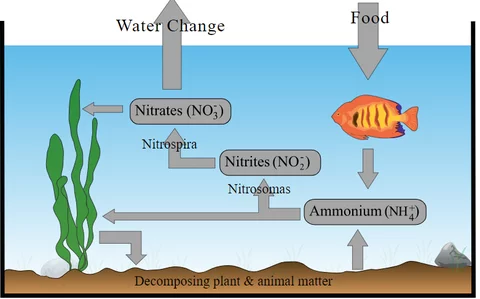
Let’s first revisit the nitration cycle. I know some of you reading this already know it, but I also know some of you may not and have become successful by listening to your local fish store on what to buy. Part of having a nitrate problem is because we are out of balance. The nitration cycle has 5 stages:
- Nitrogen is introduced with fish food
- Ammonia is excreted either by fish waste (fish poop) or decaying material
- Nitrosomas bacteria convert Ammonia to Nitrite
- Nitrobactor bacteria converts Nitrite to Nitrate
- Plants use Nitrates and Ammonium as fertilizer
The above is the natural way of how an aquatic ecosystem would work. The issue most likely with your aquarium water is that you are missing #5. If you lack live plants, nitrate levels can build up. Also, the stock media from your aquarium filters will not address #5. It is not common for filter makers to provide media that will remove nitrates. This is to keep costs down as the media designed to lower nitrates is more expensive and some buyers may not even want it.
Ways To Remove It
So now that we know the cycle, and likely what our deficiency is in the cycle, let’s talk about how to remove nitrates. You can see our video from our YouTube Channel for some visuals.
1. Water changes
This is the most common way. Water changes will reduce nitrates in the aquarium environment and bring in clean water to your fish tank. While this is an all-around fix, too many water changes can be disruptive to our closed systems. They are also labor intensive. We do not want to be a slave to the water change. Our goal is to get down to changing the water tank every other week, or every month.
2. Live Plants
A large live plant population can actually act as an effective nitrate remover for your aquarium. This works great for planted tank setups. However, I do know many people who have had nitrate problems and cannot have planted tanks. This usually happens when you’ve got fish who eat live aquarium plants, aggressive fish that uproot or damage them, or people who do not want to regularly prune live plants and maintain them.
3. Reduce livestock
Sometimes an aquarium has high nitrate levels because the fish tank is overstocked. This is common with people who follow the 1 inch per fish rule. Your biological filtration products are working overtime when your fish tank is overstocked. Other times, you have fish that are hard on your bioload such as gold fish or large aggressive fish.
4. Filters
Nitrate removers are filter media designed to remove nitrate from your aquarium either through chemical or biological means. They either come in disposable media or permanent media. They are not dangerous to the inhabitants in your tank, and will reside in your filter compartments. Some nitrate removers have mixed media, meaning that they handle other things aside from nitrate in your tank water. Some will have carbon while others use resin to remove other impurities in your aquarium water.
A dedicated nitrate removing media is a great way to target the problem immediately, but they need to be replaced regularly. A permanent media will grow anaerobic bacteria in the media. This anaerobic bacteria will consume nitrates in your tank water. If you’ve considered all these ways to reduce nitrates in your aquarium water, and are still at the point where nitrate removers are necessary, then read on for our buying guide.
The Candidates
Below is a list of the best nitrate removers for freshwater aquariums. All products here have been selected through our field experience and all are safe to use in a freshwater tank. Each have their pros and cons, which I will discuss below. There is a product for you on this list.
In a hurry? I recommend Biohome for a permanent solution and Seachem Purigen for a disposable solution.
| Picture | Name | Type | Link |
|---|---|---|---|
Editor’s Choice 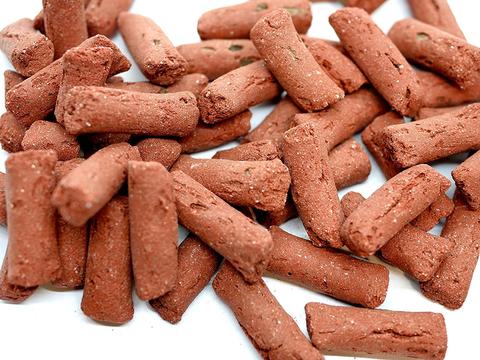 | Biohome Ultimate Filter Media | Permanent | Buy On Amazon |
Best Value  | Seachem Purigen | Disposable | Click For Best PriceBuy On Amazon |
Budget Option  | EA Premium Nitrate Reducer | Disposable | Buy On Amazon |
 | Acurel LLC Nitrate Reducing Media Pad | Disposable | Buy On Amazon |
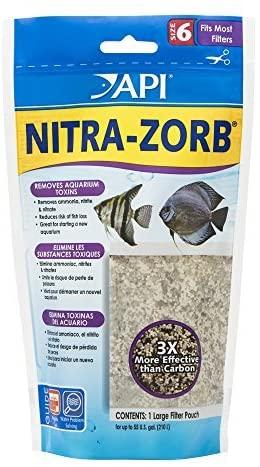 | API Nitra-Zorb | Disposable | Buy On AmazonBuy On Chewy |
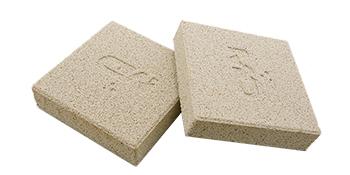 | Boxtech Aquarium Media | Permanent | Buy On Amazon |
 | Dr. Tim’s Aquatics All-Natural Aquarium Pearls | Permanent | Buy On Amazon |
 | IceCap Turf Scrubber | Permanent | Buy On Amazon |
 | Seachem Denitrate | Permanent | Buy On Amazon |
 | Seachem Matrix | Permanent | Click For Best PriceBuy On Amazon |
The Top 10 Choices (2023 Reviews)
Let’s go into further detail of each nitrate remover to see why I picked each product.
1. Bio-Home Ultimate Filter Media – The Best Biological Filtration Media
Editor's Choice!
This is the best media you can buy for your aquarium. It does it all - removes ammonia, nitrite, and nitrates
Bio-Home, in my opinion, is the best biological filtration media you can purchase, and is the best nitrate remover for freshwater tanks. It has the ability to control ammonia, nitrite, and nitrate on it’s own. Bio-Home got its start from PondGuru, one of the bigger Youtubers on pond care. PondGuru developed this product to resolve high nutrient issues in ponds. It also does an amazing job as a nitrate remover for freshwater tanks. I highly recommend it for anyone with a fish-only or lightly planted tank.
Because it is a biological based filter media, it is permanent in your system and allows for less water changes. You add it in your filter unit and forget about it. The media will house both aerobic and anaerobic bacteria and the mini-version will fit in some power filters.
It’s a great biological media, but it has one drawback. It is a very expensive nitrate remover and you will need 2-4 lbs for a mid-sized aquarium. Also, because it is biologically based it will need to establish in your fish tank before it will remove nitrates. Bio-Home offers the following guidelines when trying to figure out how much media you need to purchase.
| Environment | Amount of Biohome Required |
|---|---|
| Avg Community Tropical Tank | 1 kg/26 gal (100 lt) |
| Avg Cold Water Tank | 1-1.5 kg/26 gal (100 lt) |
| Predator Tank | 1.5-2 kg/26 gal (100 lt) |
| Large Cichlid Tank | 1.5-2 kg/26 gal (100 lt) |
| Malawi/Tanganyikan Tank | 1.5-2 kg/26 gal (100 lt) |
| Avg Mixed Fish Pond | 1 kg/52 gal (200 lt) |
| Avg Koi Pond | 1 kg/39 gal (150 lt) |
If you want a filter media that will free you of being a slave to constant water changes, this is worth every penny.
Pros
- Biological based – permanent
- less water changes
- Small enough to fit in power filters
Cons
- Expensive
- Needs to establish in your aquarium water in order to get results
2. Seachem Purigen – Instant Removal In A Small Package!
Best Value
Seachem is the most effective and quickest way to remove nitrates out of your aquarium
Seachem Purigen is a fast acting nitrate remover that uses resin to remove a number of organic compounds in your aquarium water. It is resin based and its color changes as it depletes. This makes it easy to identify when to replace or recharge the resin. Recharging the resin involves using an unscented bleach solution. The bleach burns off the organics that have been removed from the fish tank.
This type of regeneration is superior to API’s salt solution of regeneration. A salt based regeneration only replaces the removed ionic compounds. It will not destroy the large compounds that were removed. This can be risky over time as the organics can potentially leech back into your aquarium water over time. You do not really run this risk with Seachem Purigen because the price of this nitrate remover is so reasonable that many who use it don’t even bother to recharge it. It is fast acting and has great field results.
Seachem Purigen is easy to find online and at stores. It will also fit in power filters and you do not need that much to get great results for your freshwater aquarium!
Pros
- Rechargable
- Fast acting
- Good price
Cons
- Complex to recharge
3. EA Premium Pad – Budget Friendly
Budget Option
A budget friendly, yet effective nitrate removing option. Works great in canister filters
If you are looking for a budget friendly nitrate remover, the EA Premium Nitrate Reducer is a great product to look at. Like Acruel’s pad, it works instantly as it is an infused filter pad. I would install this in the second chamber of your canister filter after your mechanical stage. It will work with a power filter, but you may have difficulty getting enough of the product to be effective in smaller filters.
Make sure you rinse it before putting it into your aquarium. It’s dusty and can cloud up water if you don’t rinse it before it goes into your filter. This is a great nitrate remover for those who need fast results and are on a budget.
Pros
- Cheap
- Works instantly
- Can be cut to fit
Cons
- Dusty – rinse first before using
- Hard to find locally
4. Acurel LLC Pad – Great for Canister Filters
This is the name brand version of the EA Pad. Proven field results and fast acting
Acurel’s Nitrate Reducing Pad has been around for years and is well known for quickly taking care of nitrate problems in a freshwater aquarium. It comes in a large 10 x 18 inch pad that you can cut to size. I find this pad works best in a canister filter if the media chambers are large enough to accommodate a pad. I would put this in the chemical media chamber below your carbon media or in-lieu of.
This nitrate remover has amazing field results. It has taken down nitrate levels in a 180 gallon Cichlid tank from 60-80PPM to 20PPM or less. The biggest problem is that it’s difficult to get enough of the product into a power filter as you need to use a sizable amount of it to get the desired results. It is generally hard to find locally, making this best to purchase online. The price is very reasonable, making this a great nitrate remover if you own a canister filter.
Pros
- Can be cut to size
- Very effective
- Works quickly
Cons
- Not enough surface area to work with most power filters
- Hard to find locally
5. API Nitra-Zorb – Resin Based Carbon Replacement
A readily available and effective nitrate remove. Available online and at any local pet store
API Nitra-Zorb is a resin based filter media that works to eliminate ammonia, nitrite, nitrate, and harmful chemicals in your aquarium. It is a great all around filter media that replaces carbon in your aquarium. Because it is resin based, it can be recharged. The recharging instructions are simple. You only need aquarium salt and warm tap water to soak the media bag for 2 hours.
This makes it a really attractive media to buy for nitrate removal since you can buy a bag and reuse it, granted you are willing to recharge it regularly.
The biggest problem with using Nitra-Zorb as a nitrate remover, is that it is designed for canister filters. The bag can be too large for most power filters. Another concern is that since the bag can handle a complete nitrogen cycle on its own, it can hurt the natural biological filtration that you have set up in your filter or your aquarium plants. I feel that a nitrate remover product should be a supplement for your cycle in your aquarium, and not a replacement.
Pros
- Resin based – replaces carbon
- Media can be reused
Cons
- Bag is large and is meant for canister filters
- Expensive
6. Boxtech Aquarium Media – MarinePure Like Media That Fits In A Canister Filter
BoxTech is a ceramic media that works to remove nitrates. Best suited for sumps and canister filters
In the saltwater aquarium side of the hobby, there is this wonderful product called marinepure that is a ceramic block that acts as a superior biological filtration in sumps. The blocks are massive and have superior surface area. These blocks by BoxTech offer the same advantages as marinepure, but are designed to be small enough to fit in a canister filter.
The ceramic block will achieve a full nitrogen cycle removing nitrates. Because it is a permanent solution, you won’t have to worry about replacing media overtime. This is a less expensive long-term nitrate remover for freshwater tanks.
Unfortunately, like many products on this list, it can be difficult to fit in most power filters. It’s a 3×3 block so it may fit in larger power filters. It will also need to establish in your tank in order to achieve results.
Pros
- Convenient shape – fits in canister filters
- Incredible surface area for bacteria
- Permanent
Cons
- Won’t fit in most power filters
- Needs to establish to get results
7. Dr. Tim’s Aquatics All-Natural Aquarium Pearls – Designed By A Marine Biologist
These pearls work to remove both nitrates and phosphates from aquariums. They are best suited for fish only freshwater setups
Dr. Tim is well known by keepers of reef aquariums and public aquariums. He has designed unique products that solves issues like cycling a tank. These NP-Active Pearls by Dr. Tim are natural bio-polymers that remove nitrates and phosphates in your aquarium. They work in both freshwater and saltwater aquariums and do a great job.
Because it is a bio-ball based media, it is best run in a media reactor versus a canister filter or power filter. It will still lower the nitrate level in any of them, it’s just more effective in a media reactor.
Pros
- Permanent
- Removes phosphate and nitrate
- Small enough to fit in a power filter
Cons
- Expensive
- Works best in a media reactor
8. IceCap Turf Scrubber – Uses Algae
Turf scrubbers are well known in saltwater aquariums for removing nitrates and phosphates
An algae turf scrubber is well known in the saltwater aquarium hobby for it’s ability to remove nitrates, phosphates, and harmful chemicals in your aquarium. It does this all by growing algae on a mesh sheet. This algae once established will filter all sorts of nutrients out of your aquarium water.
A good turf scrubber will do wonders to getting your levels down, and have had field results bringing nitrates to nearly undetectable levels. This is all done naturally and is a permanent nitrate removing solution. It will also reduce algae in your display tank since the algae growth in your scrubber will compete with it. IceCap has done an excellent job at making these scrubbers as affordable as possible for hobbyist with a well made solution.
Turf scrubbers are complex to install and dial in. They require a separate pump and are best run in a sump. They are expensive and you have to remove the algae every 7-14 days. This can be messy and smelly. If you have a sump and some very high nitrate levels, this could be the best nitrate remover for you.
Pros
- Reduces nitrates and phosphates naturally
- Can eliminate nitrates to extreme low levels
- Reduces algae in display tank
Cons
- Complex to install
- Expensive
- Maintenance is messy and smelly
9. Seachem Denitrate
Denitrate is a permanent media that is soley designed to remove nitrates from aquariums
Seachem Denitrate is a biological media that has the ability to house anaerobic bacteria. Anaerobic bacteria can survive because of the porous nature of this media. It allows for areas to be depleted of oxygen which is what creates these anaerobic pockets. It functions as both basic biological media and nitrate reducing media since it is a dual purpose media.
This product from SeaChem is basically the same as SeaChem Matrix, which I will discuss next. The main difference between the two nitrate removers is that the media for SeaChem Denitrate is smaller, making it far easier for your power filters to house it. It is one of the few nitrate removing media here that will fit and be functional in a power filter. There is also a big advantage with SeaChem products in general. They are readily available online and in stores.
This 1 liter package will work for a larger size tank up to 50 gallons. It is a permanent solution, and the price is reasonable for its capacity. Because it is a permanent nitrate remover solution, it will need to establish first before any results can be seen. To function correctly, SeaChem recommends that you lower the gallons per hour on your filtration unit down to 50 gallons per hour.
Given its availability, it’s a great choice for your fish tank if you are using a power filter.
Pros
- Biological based
- Fits in power filters
- Permanent solution
Cons
- Needs time to establish
10. Seachem Matrix – Superior Biological Media Replacement
Matrix is a biological media that will provide a complete nitrogen cycle in your aquarium
Seachem Matrix is the flagship biological media product of SeaChem. It offers superior biological filtration that will house both aerobic and anaerobic bacteria species. It is a permanent nitrate reducer solution that is designed to work in canister filters. It is a larger media version of denitrate. This is done on purpose so the inner core can hold more anaerobic bacteria.
It will take time to establish given its biological nature. It is readily available in stores. This is a great solution if you are starting up a new tank and want to have great biological filter media to start.
Pros
- Biological based
- Permanent solution
- Reasonable price
Cons
- Designed for canister filters
- Takes time to establish
Our Expert Pick
There are two categories when naming a best nitrate remover. We have permanent and disposable solutions. Permanent solutions take time to establish and will solve your problem over time. Disposable solutions will work immediately and require replacement to keep levels down. We also included a video of our channel that summarizes the products from our blog post. Please subscribe if you like our content!
Best Permanent Product
This honor goes to Bio-Home Ultimate Filter Media. It has proven field results and does not have a gallon per hour limitation like some of the other permanent solutions out there. They are able to do this because the core of the media will hold anaerobic pockets for nitrate removing bacteria to thrive. I have seen bio-home reduce nitrates in pond filters pushing through 1700+ gallons per hour and still have stellar results. It is worth every penny.
Best Disposable Product
This honor goes to Seachem Purigen. The Purigen resin works immediately and is very effective. It changes color so you know when it is time to replace the media. This nitrate remover is so cheap that you don’t have to recharge the product, and you don’t need much of it. This makes it ideal for power filters. It is also readily available online and in most fish stores.
Closing Thoughts
Nitrate reduction can be a tough nut to crack in a non-planted freshwater aquarium. Overstock fish tanks have an even harder time. The great thing is that there are products that are very effective at resolving your issues with your aquarium water. I hope the overview and the product reviews I provided have helped you to make an informed decision. If you have any questions, please leave a comment below. Thank you for reading my buying guide and see you next time!
- About the Author
- Latest Posts
I’m thrilled that you found Aquarium Store Depot! Here you’ll find information on fish, aquariums, and all things aquatics related. I’m a hobbyist (being doing this since I was 11) and here to help other hobbyists thrive with their aquariums! I adhere to a high quality Editorial Process and Review products with real life field usage and practical analysis.


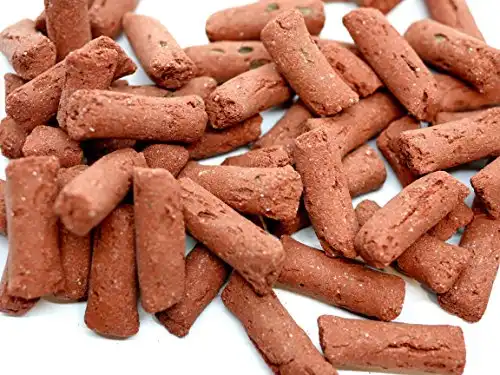
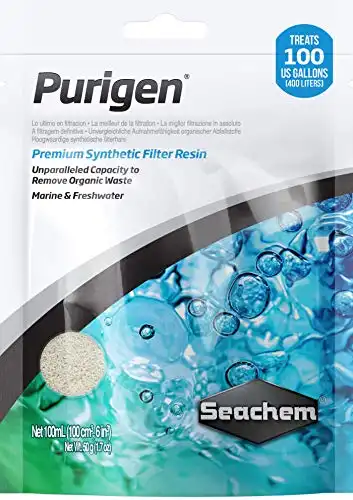
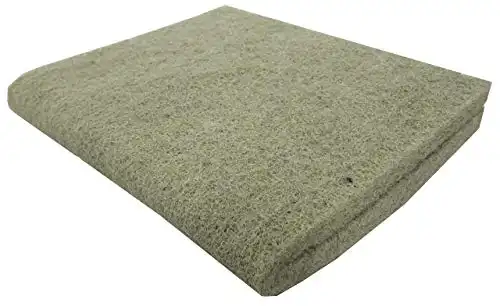
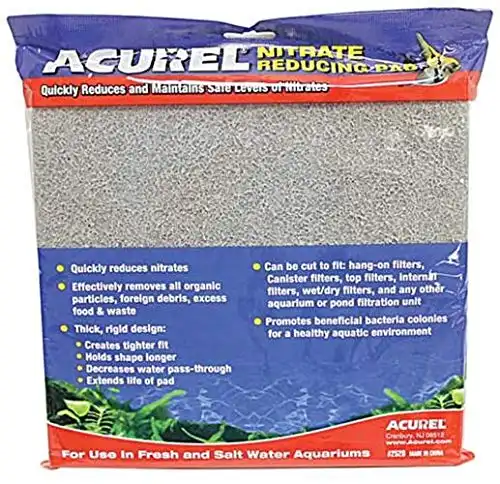
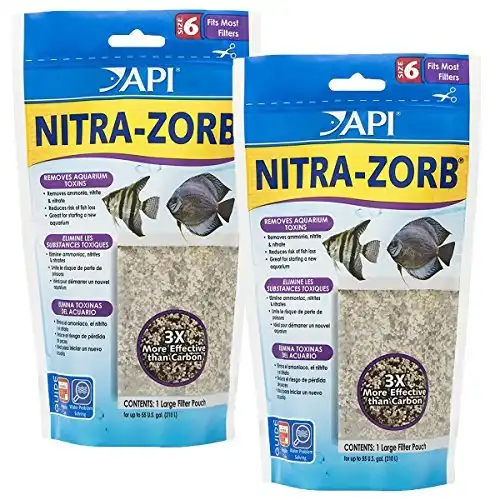
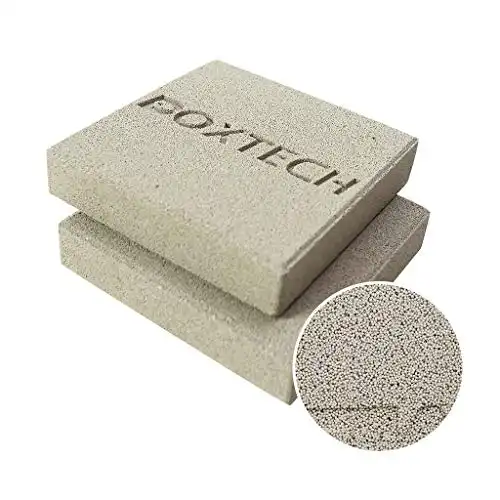
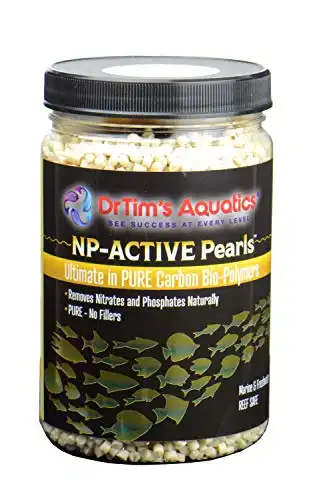

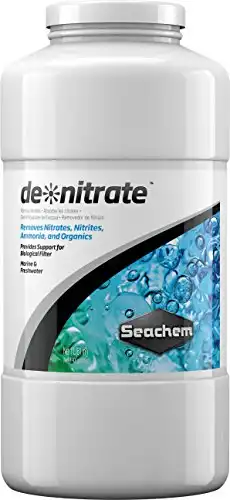





You got your Seachem product information mixed up. The 50 gallon/hour limit is for De*nitrate, not for Matrix.
Updated – thank you for the catch
Hi Mark,
hope all is well. you mentioned seachem matrix should have the flow reduced to 50 Gallon per hour. How come? Can I not just put it in my Canister Filter I have a Sunsun 304B. Also if I add let’s sat 2 or 3 pads of purigen would this help bring down the nitrates without causing issues or would this be to much. it’s a 120 Gallon tank.
Hi there. The flow needs to be lower to get the desire results. You can try Biohome Ultimate as a permanent solution
I have a 75gal African Cichlid tank with 20 3-4 inch fish and a 6inch pleco. My tank is over a year old and I do 20% water changes every 2-3 weeks. I am running two Aquaclear 110 filters. The only problem I have is high nitrates {80-160}. I would like to reduce these but how can I add 5 pounds or more of Biohome?
It would be tough with only aquaclears. You might consider upgrading to a large canister like a Fluval FX series and adding biohome. Keep the aquaclears going while your FX seeds. If you remove the biological filter to add biohome you will risk an ammonia spike.
Hi Mark, thanks for all your research. it was very helpful. my question is can the bio home or other media be out right into the large gravel of the tank opposed to the filter? Thank you.
Hi John,
Bio home is best in a filter versus being used as a substrate
I have a sponge filter in my 36 gallon bow front tank. Tap water is at 5.o ppm. I have live plants, not too many fish and a crab. Is there a liguid product I can use to reduce nitrates?
Hi Karen. There isn’t one. Seachem Purigen is gonna be your best bet.
I super frustrated. I have had an aquarium off and on for the past 25 years. I bought a new to me tank 5 years or so ago and have continually had nitrate problems.My nitrates are nearly off the charts 160+ppm. Zero ammonia or nitrites. I have added pathos plants, and currently have two fish. A pleco and a Cory cat. I don’t over feed. I have ranged from very frequent water exchanges to minimal water exchanges and it hasn’t made much of a difference.I have an Ehime pro 4+ (my old Rena filter finally died) about 3-4 years ago. I have to admit, I haven’t been as good at cleaning my filter. That could be one problem, the other thing that I’m questioning, is my substrate is rock (I used the rock from my old tank, to keep the cycling better when I started the tank. I also used the water from back then. My substrate (rocks) were for a 29 gallon tank and now I have a 40 gallon bow front. Is it possible I don’t have enough substrate, and that could be a cause of the high nitrates too? I am thinking about changing out one of my filter media for one that reduces nitrates, but I’m unsure of which filter media to remove from my Eheim. I have only used the media (besides the replaceable pads) that came with it. Which permanent one should I remove to place the nitrate reducing media? Bottom, middle or top?
Thanks for any advice.
Hi there. I would test your tap water and see what nitrates are reading. Sometimes the source water can have very high nitrates. Other than that, you can try some nitrate reducing media and place that at the last stage of the filter. You may be overstock, but I don’t know how large your fish are. Pleco is a broad fish species as some can get very large so you may be overstocked. I would say source water, overstocking, and not enough filtration might be the issue. Some plants like duckweed could help if you are willing to grow them. Best of luck.
Interesting article but I don’t get how I’m supposed to put 2 kg of Bio-Home Ultimate Filter Media for my 55 gallon tank into my Fluval 307 or any canister filter? I’ll probably go with Seachem Matrix but you were really pushing that Bio-Home solution so I figured I’d ask. Thank you.
Hi JC,
For Biohome, canister filters will run 2 biological media chambers. So your chemical media would be replaced in favor of biohome. You would have a single mechanical chamber and you place a polishing pad at the bottom of the 3rd chamber. Seachem matrix is a good alternative if your space is limited.